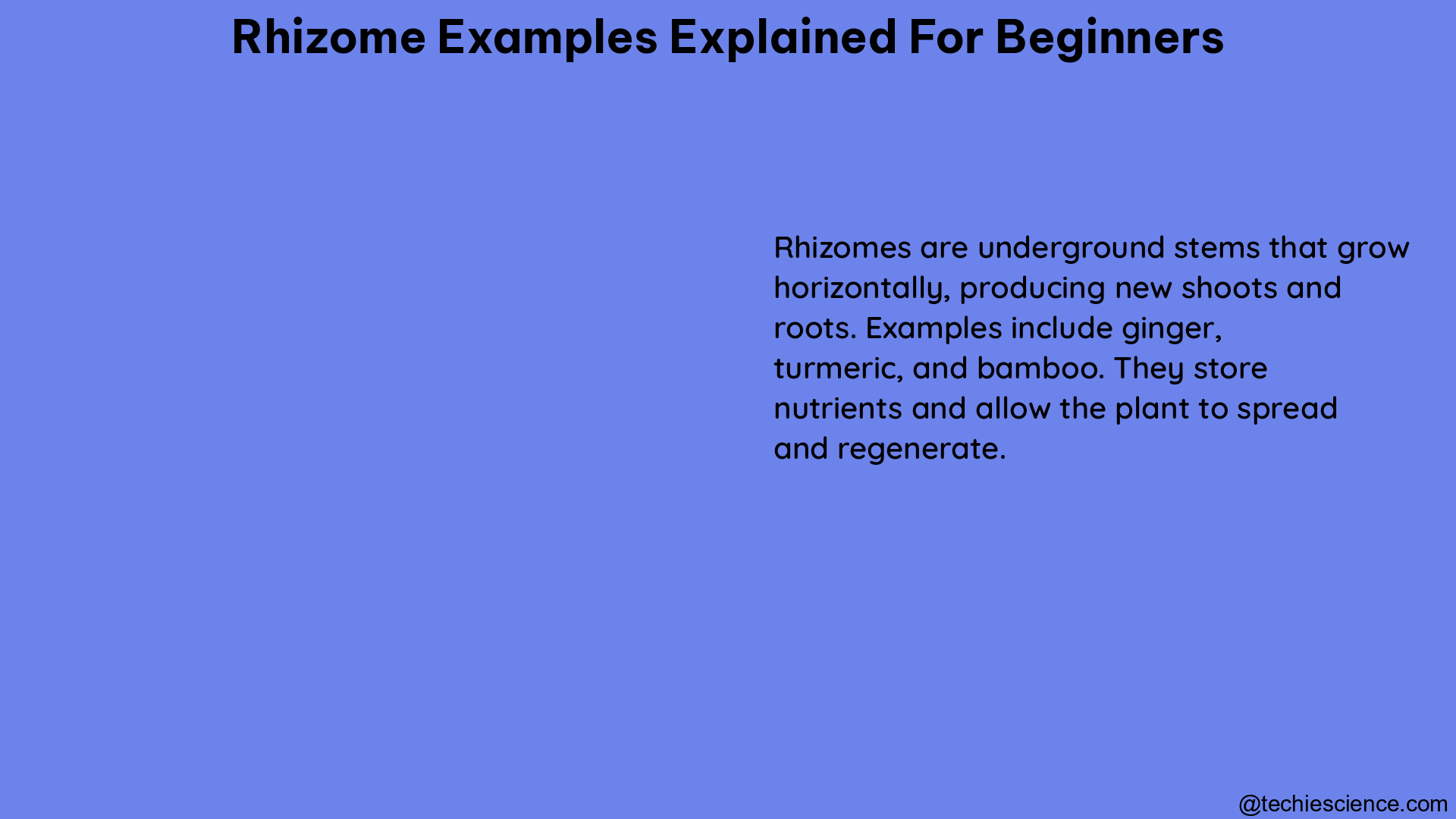Rhizomes are modified subterranean stems that play a crucial role in plant growth, reproduction, and survival. These horizontal, underground stems send out roots and shoots from their nodes, making them an essential concept in plant biology. In this comprehensive guide, we’ll explore the biological specifications and quantifiable data points of various rhizome examples, providing beginners with a deeper understanding of these remarkable plant structures.
Ginger (Zingiber officinale): The Aromatic Rhizome
Ginger is a widely used rhizome in cooking and traditional medicine. Its rhizomes can grow up to 1 meter in length and 2 centimeters in diameter. These rhizomes are rich in essential oils, which give ginger its characteristic aroma and flavor. Ginger’s essential oil content can range from 1% to 3%, with the primary compounds being gingerol, shogaol, and zingerone. These compounds not only contribute to ginger’s distinctive taste but also possess potent antioxidant and anti-inflammatory properties, making ginger a valuable medicinal plant.
Bamboo (Bambusoideae): The Rapid-Growing Rhizome

Bamboo is a fast-growing grass with an extensive rhizome system. The rhizomes of bamboo can grow up to 1 meter per day, with some species reaching lengths of over 100 meters. Bamboo rhizomes have a high tensile strength, which makes them useful in construction and textile industries. The rhizome structure of bamboo is characterized by its segmented nodes and internodes, allowing for rapid growth and efficient nutrient and water transport. Bamboo rhizomes can also form dense, interconnected networks, enabling the plant to spread and colonize new areas effectively.
Turmeric (Curcuma longa): The Medicinal Rhizome
Turmeric is another culinary and medicinal rhizome. Its rhizomes can grow up to 60 centimeters in length and 5 centimeters in diameter. Turmeric rhizomes are rich in curcumin, a potent antioxidant and anti-inflammatory compound. Curcumin content in turmeric rhizomes can range from 2% to 8%, depending on the cultivar and growing conditions. Turmeric has been used in traditional medicine for centuries, and its therapeutic properties have been extensively studied, making it a valuable addition to the rhizome family.
Iris (Iridaceae): The Diverse Rhizome
Irises are a diverse group of perennial plants with rhizomes that vary in size and shape. The rhizomes can grow up to 30 centimeters in length and 2 centimeters in diameter. Iris rhizomes serve as storage organs, allowing the plants to store nutrients and water, which is particularly important for their survival during dry spells. The rhizome structure of irises is characterized by its segmented nodes and internodes, similar to bamboo, but with a more compact and branching growth pattern. Irises are known for their vibrant and diverse flower colors, which are often associated with the rhizome’s growth and development.
Lotus (Nelumbo nucifera): The Starch-Rich Rhizome
The lotus is a sacred plant in many cultures, with rhizomes that can grow up to 1.5 meters in length and 10 centimeters in diameter. Lotus rhizomes are rich in starch, making them a valuable food source in some countries. The starch content in lotus rhizomes can range from 15% to 25%, depending on the cultivar and growing conditions. Lotus rhizomes also contain various bioactive compounds, such as flavonoids and alkaloids, which have been studied for their potential health benefits. The unique growth pattern and size of lotus rhizomes make them an impressive example of the diversity and adaptability of these plant structures.
These rhizome examples provide a comprehensive overview of the biological specifications and quantifiable data points that beginners can use to understand the role of rhizomes in plant biology. By exploring the unique characteristics of each rhizome, from the aromatic ginger to the rapid-growing bamboo, and the medicinal turmeric to the diverse iris and the starch-rich lotus, we can gain a deeper appreciation for the remarkable adaptations and functions of these underground plant structures.
References:
- Reshaping Plant Biology: Qualitative and Quantitative Descriptors in Plant Geometry, Topology, and Shape
- Qualitative vs. Quantitative Data: What’s the Difference?
- 3.6 Quantitative Data Analysis
- Ginger (Zingiber officinale) Rhizome: Chemical Constituents, Bioactivities, and Health Benefits
- Bamboo: The Supergrass
- Turmeric: The Golden Spice
- Iris Rhizome Anatomy and Physiology
- Lotus (Nelumbo nucifera) Rhizome: A Potential Source of Bioactive Compounds

The lambdageeks.com Core SME Team is a group of experienced subject matter experts from diverse scientific and technical fields including Physics, Chemistry, Technology,Electronics & Electrical Engineering, Automotive, Mechanical Engineering. Our team collaborates to create high-quality, well-researched articles on a wide range of science and technology topics for the lambdageeks.com website.
All Our Senior SME are having more than 7 Years of experience in the respective fields . They are either Working Industry Professionals or assocaited With different Universities. Refer Our Authors Page to get to know About our Core SMEs.